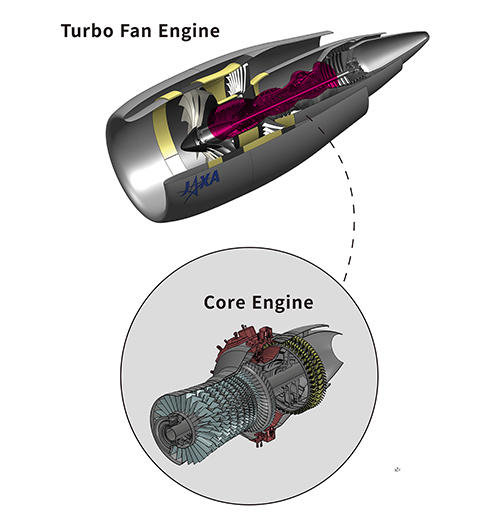Aeronautical Technology Directorate
For more environmentally friendly aeroengines
Launch of the En-Core Project
Core engine technologies would be the key to the growth of Japanese aviation industry
JAXA not only conducts aerospace exploration, but also develops aviation technology at its Aeronautical Technology Directorate. This division conducts a wide-ranging aeronautical research and development to help advance our society--such as developing supersonic passenger aircraft technologies and creating systems that enable safer and more efficient operation management of rescue helicopters in times of disaster.
Of particular note is the core engine technology demonstration project named "En-Core" that was launched in April of this year. The conceptual study started about three years ago, and it was just recently made into an official project. Core engine is the heart of the turbo fan engine. The Aeronautical Technology Directorate had been promoting the "aFJR" project that seeks to increase efficiency and decrease the weight of low-pressure systems such as the fans and low-pressure turbines that are placed at the inlet and outlet of the jet engines. "En-Core" focuses on high-pressure parts in the core of engines, which is another area of challenge for the next step.
Takashi Yamane, who leads the team as the Project Manager, commented: "Over the next five years, we will work together with the engine manufacturers in Japan to advance our research and development."
"Our goal is to improve the practicability of our research results that we have been building up over the years, and acquire the technological capabilities to compete with the world jet engine manufacturers. Eventually, we hope to have the manufacturers take the fruits from this project for practical application and commercialization, with the aim of having these technologies be implemented into engines for aircrafts which will enter into service during the 2030s."
The various major modules that consist of an aircraft engine are developed by different manufacturers, both in and outside of Japan. Japanese manufacturers have a good share of the market for low-pressure systems. However, the world major manufacturers design the overall engines, produce high-pressure core engines which are the heart of the engine system, and then assemble the whole engine because they dominate the market for jet engines. Thus, Japan's aircraft engine industry would be able to make a dynamic leap forward if we are able to increase the share of core engines that are made in Japan.
Gathering together what we've achieved through past research in order to build what would be helpful to the world
The name En-Core is derived from the words "environment" and "core," and is so named because it is a core engine that places importance on environmental concerns. In order to create an engine that has low impact on our environment, we are going to develop and demonstrate the technologies for the combustor that burns the fuel, and the high-pressure turbine that rotates to generate force through the project. The main mission of the project is to reduce the emission of NOx (nitrogen oxide) from the combustor, and to reduce CO2 (carbon dioxide) emission from the engine by improving the efficiency of the high-pressure turbine. To do so, both the combustor and the turbine need to be made more resistant to high temperatures. Thus, Yamane says that the key is in bringing innovation to the materials that are being used.
"We will be using CMC (Ceramic Matrix Composites), which is more heat resistant than the metal that we have been traditionally using, for both the combustor and the high-pressure turbine. I am sure that CMC will be getting more commonly used in the future. We hope to lead the world with our research in such developments."
Yamane continues: "Our members have been producing results in what we have continued to believe to be of worthy research; but from now on, we will be striving in our endeavor with a stronger awareness that we are creating something that will continue to serve our world." Their challenge, of giving shape to what they have nurtured thus far, has only just begun.

Read also:
"Accelerating core engine technology research" on JAXA Aeronautics Magazine FLIGHT PATH (Winter 2018)
https://www.aero.jaxa.jp/eng/about/publications/magazine/flightpath/fp22/fp22_p4.html
- Home>
- Global Activity>
- Public Relations>
- JAXA’s>
- JAXA's No.77>
- Launch of the En-Core Project